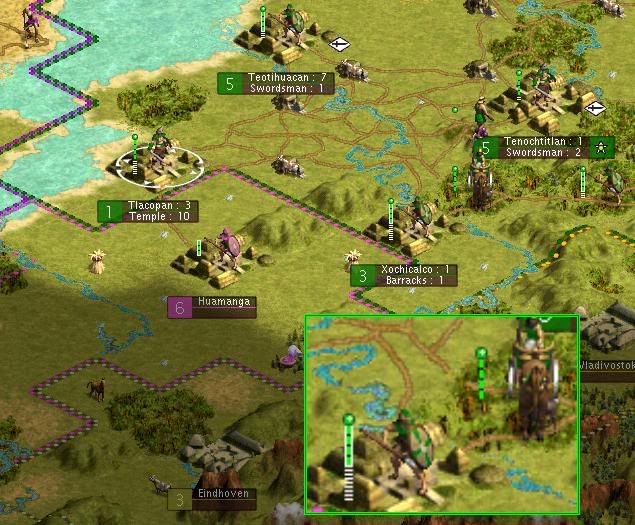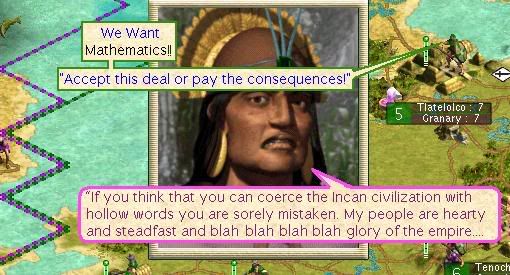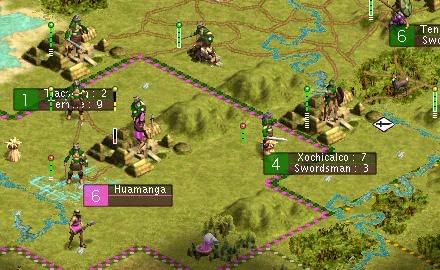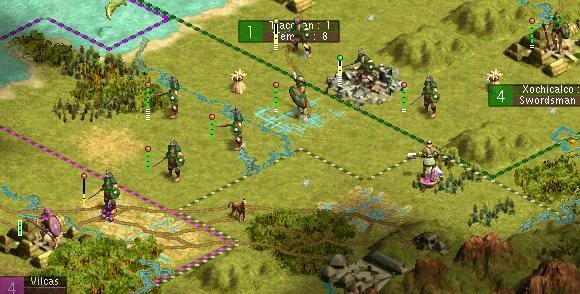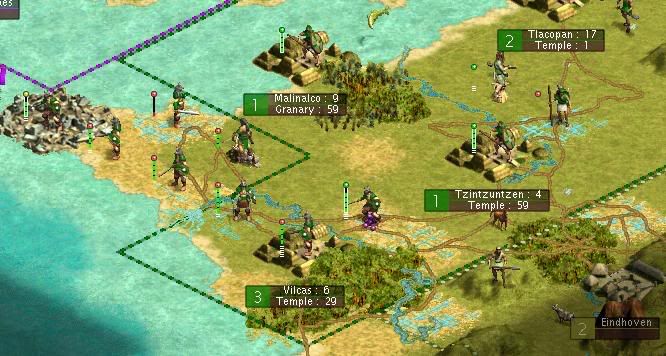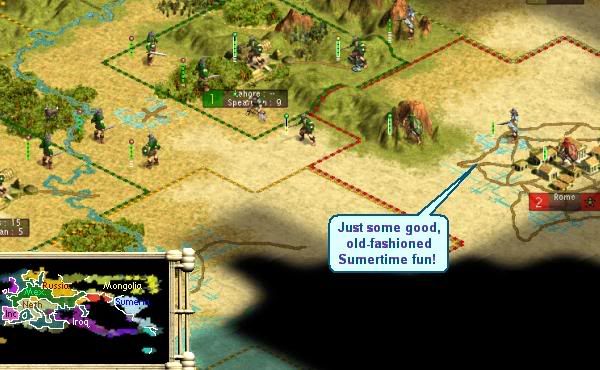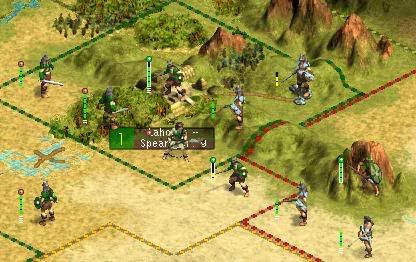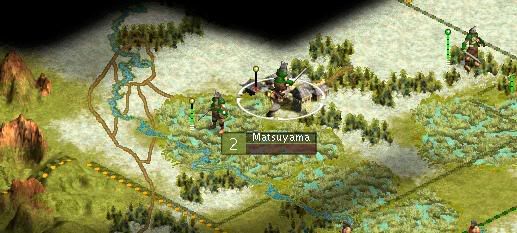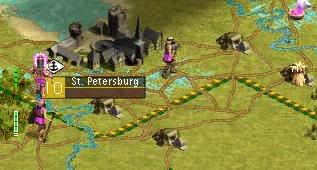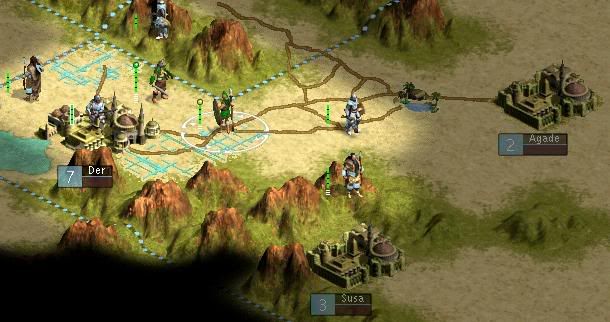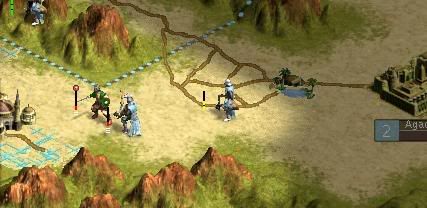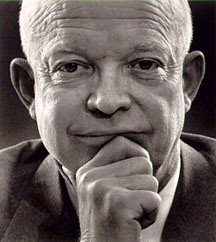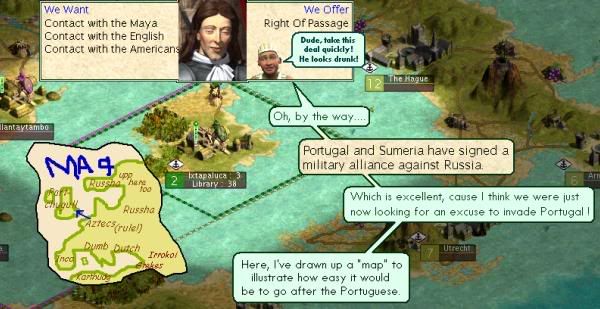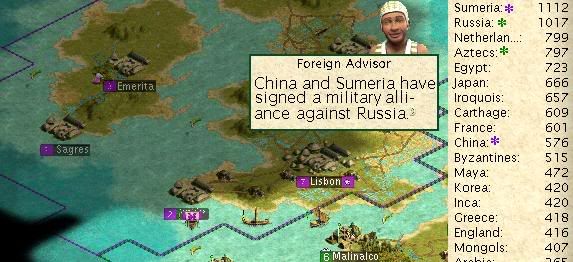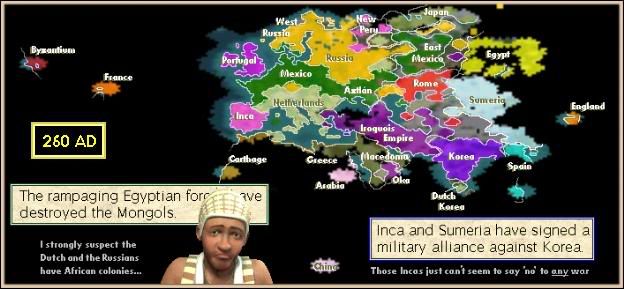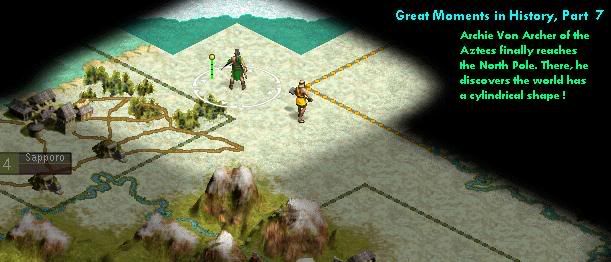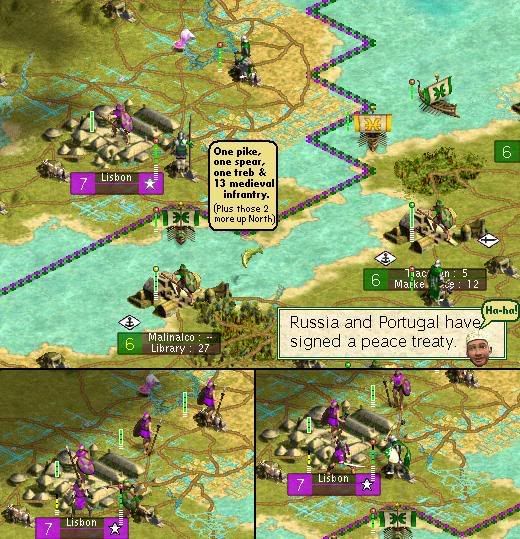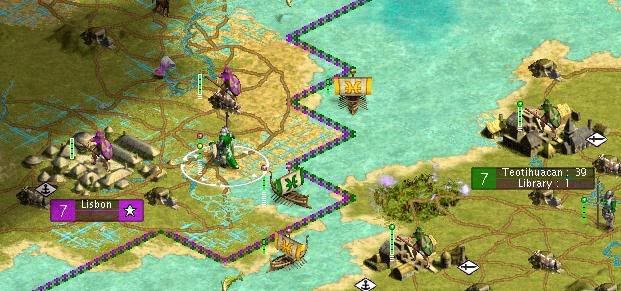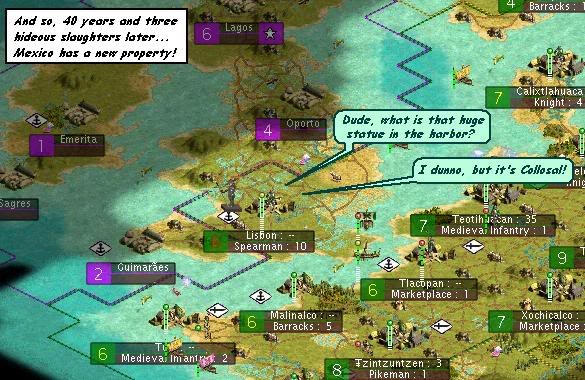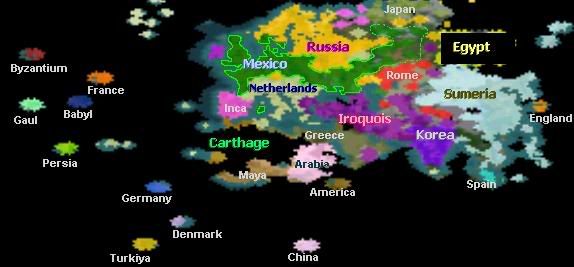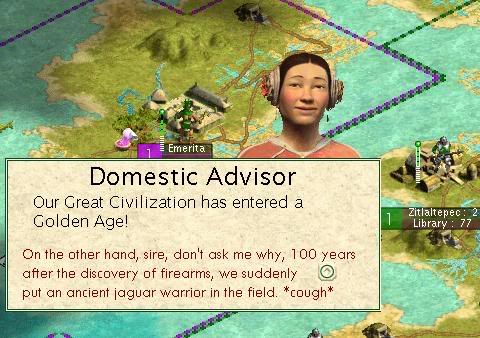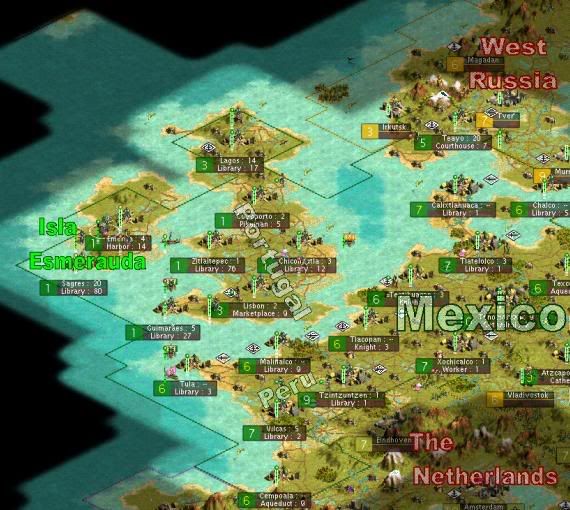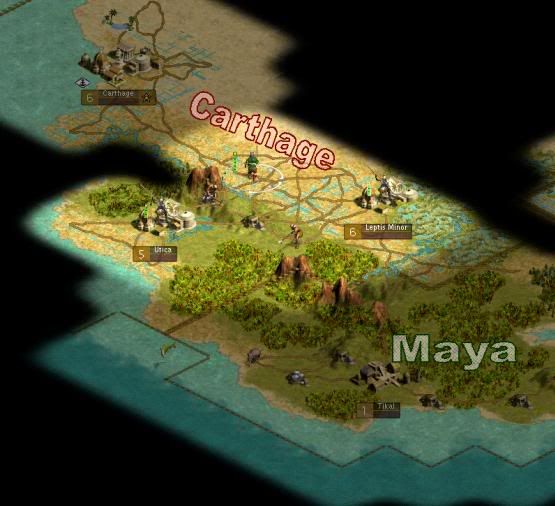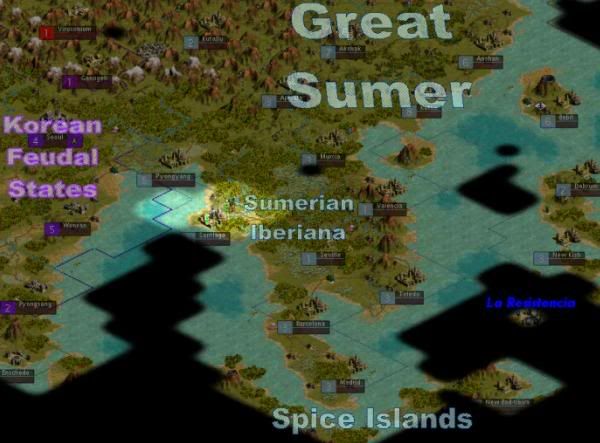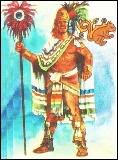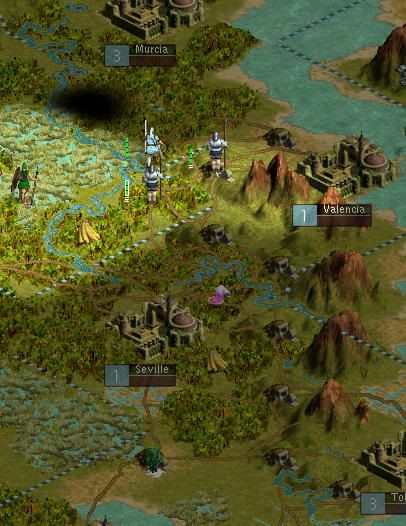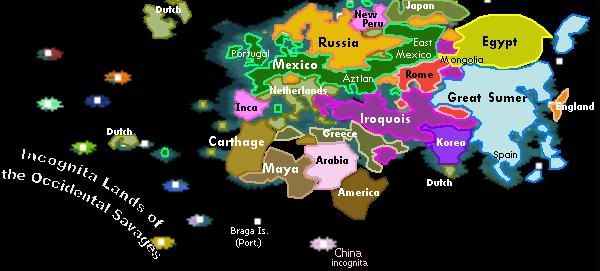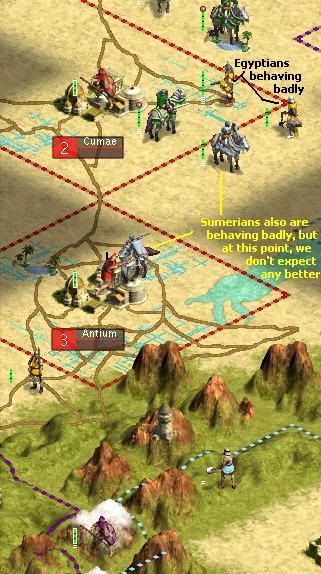You may thank Hurricane Ike for clearing out my schedule long enough for me to start posting this. As I post this in September 2008, I can report that the game and the rough draft of the story is actually played to the late 15th Century, so regular updates (unlike my last story--still unfinished) won't be a problem.
NB: This story is being played on the Earth Map with the enlarged Europe, which I've found ends up giving you a game much closer to RW* history. I'm playing with 31 civs on Monarch level. That tends to slow down the between-turn-rounds because of the massive AI activity. I've modified the game a bit. Except for settlers, most foot units travel two squares per term--a few like samurai, spearmen, Impi, & marines travel three. Mounted & motorized units travel four or more. The point was to speed up the action in the game and force the human player to ramp up the defensive lines.
To this end, I've also reduced the cost of military units and pumped up the number of free units for each government type. (Fascists are totally dangerous in this gameplay). I also added a new government type, Tribalism, which is more efficient than despotism but xenophobic & militarily weak. This is meant to put on the planet civs like the Amerinds or the Aborigines who are more advanced than barbarians, but non-acquisitive.
Finally I adapted in a few new units. Late in musket-era technology nations can build grenadiers--elite, expensive, assault musket units (4.3.2) who can carry out amphibious assaults. You shouldn't have to wait until Marines before you can take over a one-square island and wipe out a reduced enemy. I always thought cavalry were too powerful too soon, so I took the Hussar unit from unlocked Austria and renamed it Lancer (5.3.5), which you get with military tradition. You need industrialization to develop heavy cavalry of the 19th century variety (7.4.5).
I always thought guerrillas were dumb, being weaker, but just as expensive as riflemen. So I changed them to "contras"--expensive and weak but stateless land pirates for harassing your enemies. The AIs ended up using those against me quite well. I also beefed up the privateers (from 2-1 to 3-1). Also, now anyone can build crusaders (provided you have spices--as a hat tip to the real reason for the Crusades) and anyone can build elephants (provided you have both ivory and incense). To make it up to the Indians for losing their unique unit, they got bowmen as a consolation prize. Still, the poor bums didn't last very long in this game, it turns out, so maybe I owe them one.
Okay, too much jibber-jabber. Here's my intro.
NB: This story is being played on the Earth Map with the enlarged Europe, which I've found ends up giving you a game much closer to RW* history. I'm playing with 31 civs on Monarch level. That tends to slow down the between-turn-rounds because of the massive AI activity. I've modified the game a bit. Except for settlers, most foot units travel two squares per term--a few like samurai, spearmen, Impi, & marines travel three. Mounted & motorized units travel four or more. The point was to speed up the action in the game and force the human player to ramp up the defensive lines.
To this end, I've also reduced the cost of military units and pumped up the number of free units for each government type. (Fascists are totally dangerous in this gameplay). I also added a new government type, Tribalism, which is more efficient than despotism but xenophobic & militarily weak. This is meant to put on the planet civs like the Amerinds or the Aborigines who are more advanced than barbarians, but non-acquisitive.
Finally I adapted in a few new units. Late in musket-era technology nations can build grenadiers--elite, expensive, assault musket units (4.3.2) who can carry out amphibious assaults. You shouldn't have to wait until Marines before you can take over a one-square island and wipe out a reduced enemy. I always thought cavalry were too powerful too soon, so I took the Hussar unit from unlocked Austria and renamed it Lancer (5.3.5), which you get with military tradition. You need industrialization to develop heavy cavalry of the 19th century variety (7.4.5).
I always thought guerrillas were dumb, being weaker, but just as expensive as riflemen. So I changed them to "contras"--expensive and weak but stateless land pirates for harassing your enemies. The AIs ended up using those against me quite well. I also beefed up the privateers (from 2-1 to 3-1). Also, now anyone can build crusaders (provided you have spices--as a hat tip to the real reason for the Crusades) and anyone can build elephants (provided you have both ivory and incense). To make it up to the Indians for losing their unique unit, they got bowmen as a consolation prize. Still, the poor bums didn't last very long in this game, it turns out, so maybe I owe them one.
Okay, too much jibber-jabber. Here's my intro.
The Aztec Golden Age (and other tales)
1. Introduction
This is a tale of the Aztec Empire, but like most histories, it will not tell you the full story. Great men will be forgotten. Great deeds will go unsung. No witness saw them or no bard sang their song or maybe they served their greatness to history from the shadows--the servant, the cook, the mistress, the bodyguard. The heroic chauffeur or the valiant fisherwoman walked her hour on the planet's surface and disappeared with nary a portrait to tell us today of her beguiling charms or her steely determined eyes. A mopy son of a monarch holds her place in the annals of Mexico because his older brother died in his youth, bringing the talentless dilettante to the throne instead. The brilliant mechanic who redesigned some machine of industry has lost his name in the song of man because his ruthless employer took the credit and the profits from his invention. The actors grab the glory of the stagelights and the playwrights who made them poetry to sing lurk in the shadows unapplauded.
This is one of those kinds of stories.
This is the story of Mexico in its most glorious years: from the final conquest of the Portuguese Isles to the formation of the African Alliance to the fall of Old Carthage. It is not the most important chapter in world history; it does not recount the greatest wars this Earth has seen. But it was in these medieval times that the character and destiny of the Aztecs molded itself upon the crucible of war. I will not tell you of Mexico's finest hour. I will tell you of how the Aztecs found their nation's soul.
Table of Contents
Spoiler :
Backstory Part One: Alas, Peru
Backstory Part Two: Stabs at Greatness
Backstory Part Three: Alchemy
Backstory Part Four: Being There
Backstory Part Five: Vital Stats
Chapter 1: Recon Jobs
Chapter 2: Jockeying for position
Chapter 3: Just a Map
--Bucky
![Civ3 Conquests [c3c] [c3c]](/images/smilies/c3c.gif)


